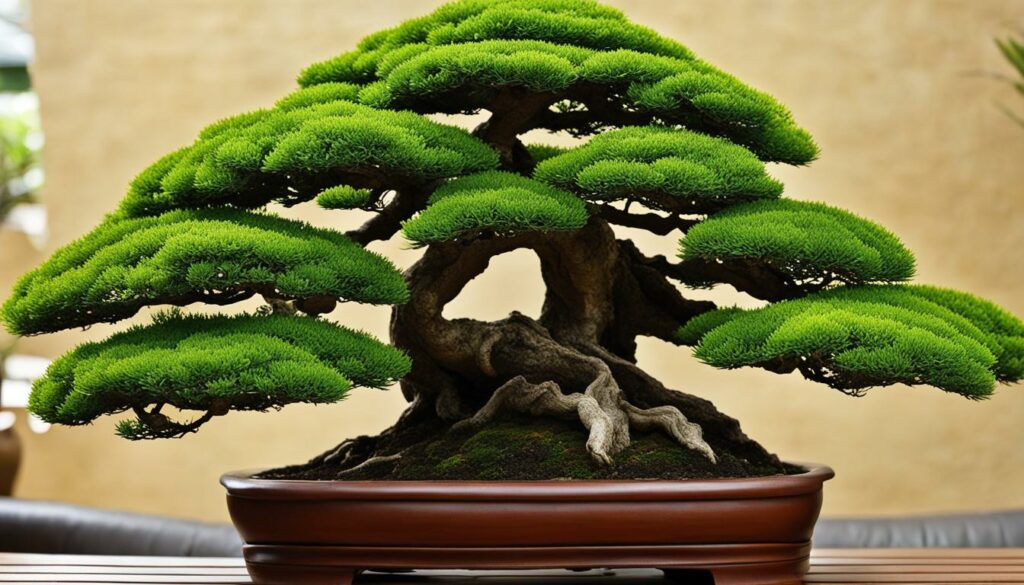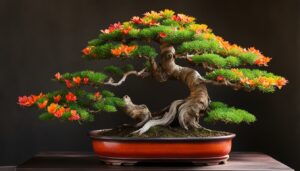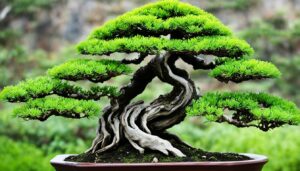Are you an experienced bonsai enthusiast looking to take your skills to the next level? Look no further than advanced bonsai shaping techniques. These techniques are specifically designed for those seeking to refine and perfect their miniature masterpieces.
With advanced shaping techniques, you can elevate your bonsai artistry to new heights and create truly remarkable designs. In this comprehensive guide, we’ll explore complex styling, artistic techniques, and advanced shaping methods that can help you achieve bonsai mastery.
Whether you’re looking to enhance your bonsai’s trunk movement and taper, perfect its nebari and root systems, or create lifelike canopy silhouettes, this guide has you covered. With dedication and practice, these advanced shaping techniques can help you develop your unique artistic style and become a true bonsai expert.
Key Takeaways:
- Advanced bonsai shaping techniques can refine and perfect miniature masterpieces.
- Complex styling, artistic techniques, and advanced shaping methods play significant roles in creating stunning bonsai designs.
- Enhancing trunk movement and taper, perfecting nebari and root systems, creating lifelike canopy silhouettes, and utilizing advanced wiring techniques are important in advanced bonsai shaping.
- Refining Jin and Shari techniques, applying advanced defoliation techniques, and embracing advanced styling tools and techniques can help elevate your bonsai artistry to new heights.
- Maintaining and displaying your advanced bonsai creations is essential to showcasing them in the most captivating way.
Understanding Complex Styling
Advanced bonsai shaping requires a deep understanding of complex styling. Creating a stunning bonsai design involves various artistic techniques that are unique to this specialized art form. By mastering these techniques, you can elevate your bonsai artistry to the next level.
While there are countless techniques involved in bonsai styling, some of the most critical include:
- Pruning – the process of removing and shaping leaves and branches to control the overall shape and size of the bonsai tree.
- Wiring – a technique used to bend and position branches into a desired shape.
- Grafting – the process of combining parts of two different trees to create a unique and striking bonsai design.
- Deadwood carving – a technique used to create lifelike jin and shari (dead wood and exposed trunk) features that add character and age to your bonsai.
These techniques require a combination of skill and artistic vision. With practice and patience, you can refine your bonsai mastery and create stunning miniatures that are truly works of art. Understanding complex styling is a crucial element of advanced bonsai shaping and creates a strong foundation for elevating your bonsai design and style.
Mastering Branch Structure
If you want to elevate your bonsai artistry to the next level, mastering branch structure through advanced shaping techniques is crucial. To achieve a visually appealing and balanced branch layout, follow these essential tips and tricks:
- Shape branches incrementally, moving from thicker to thinner branches. This will add depth and dimension to your design.
- Eliminate branches that grow towards the trunk or cross over each other to maintain a clean, streamlined look.
- Create negative space between branches to accentuate each individual branch’s unique characteristics.
- Rotate the tree often to view the branches from different angles, ensuring a balanced and proportional layout.
- Refine branch texture through advanced carving techniques, such as jin and shari, to add character and age to your design.
Remember, advanced bonsai shaping takes time and patience, but the results are worth the effort. With practice, you can achieve bonsai mastery and create stunning miniature masterpieces that showcase your unique artistic style.
Tip: Branch structure is key to creating an aesthetically pleasing bonsai. By mastering this technique, you can take your bonsai artistry to new heights and create designs that are both visually appealing and technically precise.
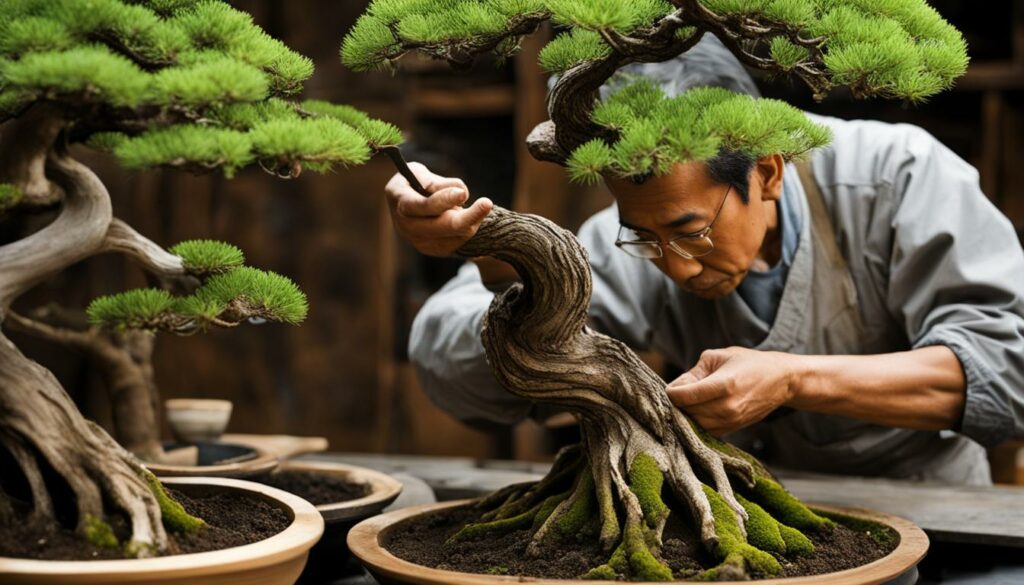
Enhancing Trunk Movement and Taper
Creating captivating trunk movement and taper is essential to enhance the natural beauty of your bonsai. The proper utilization of advanced shaping techniques can help achieve stunning results. Here’s a step-by-step guide on how to enhance your bonsai’s trunk movement and taper:
- Identify the current trunk line: The first step is to evaluate the current trunk line and decide on the desired final shape. You can use wires to reshape the trunk gradually and achieve the desired posture.
- Implement Jin and Shari: Use the jin technique to create deadwood features on the bark to add character and age to the trunk. Similarly, implement shari to expose a portion of the bark on the trunk and create a realistic natural-looking bonsai.
- Create a gradual taper: A gradual taper of the trunk adds an element of naturalness to the design. You can use wires to gradually reduce the thickness of the trunk and create the desired taper.
- Use carving tools: Advanced bonsai shaping involves the use of proper carving tools to achieve a refined and precise design. Apply carving tools to create grooves, ridges, and valleys on the trunk to give a lifelike feel to your bonsai.
Make sure to implement these techniques mindfully and give your bonsai ample time to adjust after each shaping step. With patience and practice, you can achieve the desired level of bonsai mastery.
Perfecting Nebari and Root Systems
If you want to achieve bonsai mastery, refining the surface roots and root system is critical to creating a harmonious bonsai design. The nebari, or surface roots, serve as a foundation for your miniature tree, and a well-developed nebari can add a sense of age and stability to the overall design.
One aspect of perfecting your bonsai’s nebari involves selecting the right pot to promote healthy root growth and prevent overcrowding. A shallow pot allows for better visually appealing surface roots and promotes a more balanced overall design.
Another advanced shaping technique that can enhance the nebari and root system is air layering. Air layering is a process where a branch’s outer bark is stripped away, and a rooting hormone is applied to encourage the growth of new roots. This technique allows for precise placement of new root structures, resulting in a more aesthetically pleasing nebari and root system.
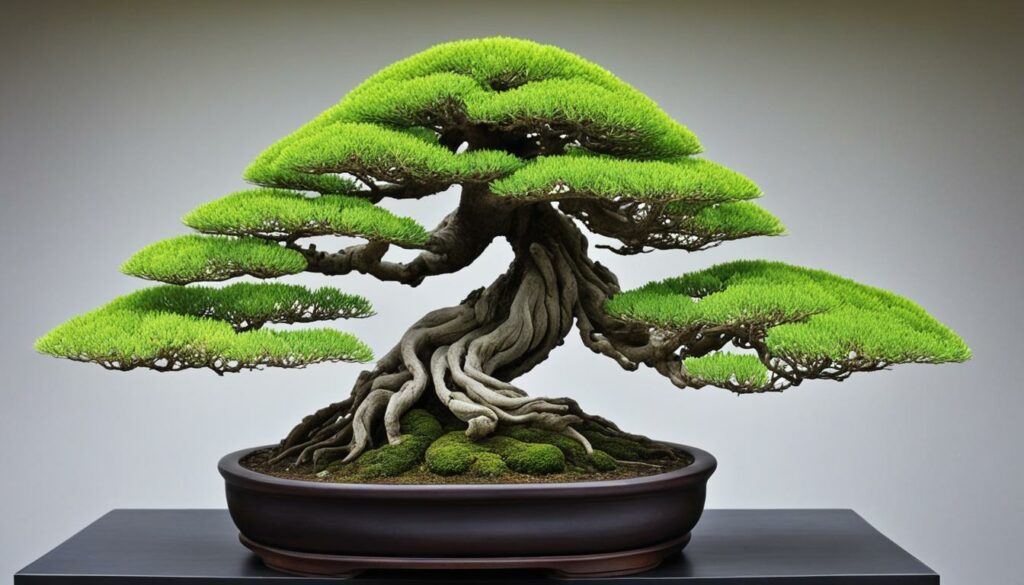
Selecting the Right Soil Mixture
Using the correct soil mixture is also crucial for maintaining the health and appearance of your bonsai’s root system. A well-draining soil mixture allows for better oxygen flow to the roots, promoting healthy growth and development. For optimal results, consider mixing coarse sand, peat moss, and vermiculite for the perfect soil blend.
Regular Root Pruning
Regular root pruning is another advanced technique that can help perfect the nebari and root system. By periodically pruning the roots, the bonsai’s overall root system remains well contained, allowing for better tree stability, creating a balanced look, and promoting healthy growth. Use sharp and precise tools, such as concave branch cutters, for clean cuts that promote successful root regrowth.
Creating Lifelike Canopy Silhouettes
Bonsai trees are incredible works of art that require intricate attention to detail. Creating a lifelike canopy silhouette is a complex styling technique that requires a combination of artistic techniques to mimic the majesty of full-sized trees.
To achieve a visually engaging foliage pattern, advanced shaping techniques are employed to create realistic branch placements and canopy shapes. The goal is to create a miniature tree that looks like it’s been plucked from the forest, fully formed with a natural silhouette.
One artistic technique that works well for creating lifelike canopy silhouettes is the use of branch layering . By combining this technique with other advanced styling techniques, like crown reduction and directional pruning , bonsai artists can create breathtaking foliage patterns that look natural and life-like.
Here’s how it works: first, you should start by identifying the primary branches of the tree. These are the larger, visible branches that create the foundation of the canopy. Next, you can create a second layer of branches by wiring smaller branches at an angle close to the main branch. This process is continued until the desired density is reached.
This table shows some of the key artistic techniques that can be used to create stunning lifelike canopy silhouettes.
| Artistic Technique | Description |
|---|---|
| Branch Layering | Creates a realistic layered effect in the canopy |
| Crown Reduction | Reduces the height and size of the tree’s top to allow light into the lower branches, promoting growth |
| Directional Pruning | Shapes the tree’s future growth pattern by removing unwanted branches or foliage |
Why create a lifelike canopy silhouette?
A lifelike canopy silhouette is an essential aspect of creating a realistic-looking bonsai tree. It gives the tree a natural appearance that is both visually appealing and calming. Furthermore, it’s a hallmark of skill and mastery for bonsai enthusiasts who aim to create breathtaking miniature works of art.
By employing advanced techniques like branch layering, crown reduction, and directional pruning, you can achieve a lifelike canopy silhouette that’s a true masterpiece of complex styling and artistic techniques.
Utilizing Advanced Wiring Techniques
As an advanced bonsai enthusiast, you know that shaping and manipulating your tree’s branches to perfection is an art form that requires both skill and precision. That’s where advanced wiring techniques come in.
The art of wiring involves wrapping copper or aluminum wire around your bonsai branches to guide their growth and shape them into your desired design. While wiring is a powerful and versatile technique, it must be employed with caution because improper use can lead to branch breakage or scarring.
Here are some expert tips on proper wiring methods to create intricate and aesthetically pleasing designs:
Choose the Right Wire
The right wire size and material are crucial for successful wiring. The wire must be strong enough to hold the branch in place, but not so thick that it causes damage or scars the bark. Copper wire is typically preferred due to its flexibility and ease of use, but aluminum wire is also a popular choice.
Expert Tip: In general, the thickness of the wire should be approximately two-thirds the diameter of the branch being shaped.
Wrap Securely and Neatly
When wrapping wire around your bonsai branches, make sure to do so carefully and neatly. Overlapping wires can cause bulges or scars on the bark, and loosely wrapped wires can slip and cause damage to the branch or the adjacent ones. Wrap the wire tightly but not too tight to avoid scratching the bark.
Expert Tip: Wrap the wire in the opposite direction to the direction you want the branch to bend. This will help the wire hold its position better when you start to bend or twist the branch.
Remove the Wire on Time
As the branch continues to grow, the wire can begin to bite into the bark and cause damage. Therefore, it’s essential to remove the wire on time before it scars the branch. Check your bonsai regularly, and remove the wire before it becomes too tight.
Expert Tip: Avoid leaving the wire on your bonsai for more than six months, but also make sure to remove it before it starts cutting into the bark.
Mastering the art of advanced wiring can take time and practice, but with these tips, you’ll be on your way to creating intricate and beautiful designs that highlight your advanced bonsai mastery. Keep exploring new techniques and refining your skills with each wiring project.
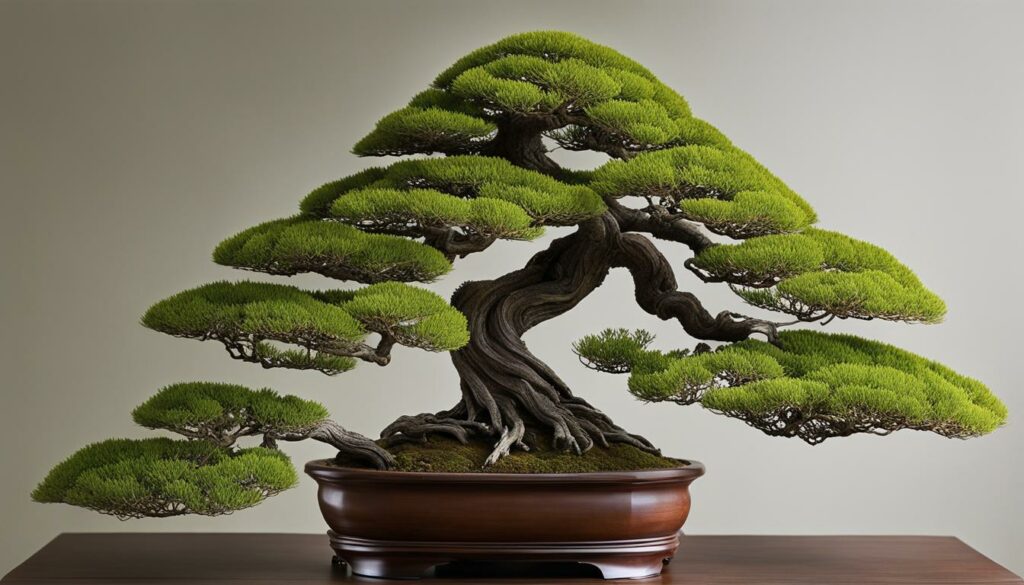
Incorporating Grafting for Unique Designs
Take your bonsai artistry to the next level by incorporating advanced grafting techniques into your creative process. These techniques allow you to combine different trees or varieties, creating unique and striking bonsai designs. Grafting is also a valuable tool for repairing damaged bonsai or replacing weak or undesired branches.
Grafting involves fusing two separate parts of a tree together so that they grow as one. The process is intricate and requires patience and skill, but the results are well worth the effort. There are many grafting techniques to choose from, including approach grafting, thread grafting, and side grafting.
Basics of Grafting
Grafting requires precise cuts and a steady hand. Before starting, ensure your tools are clean and sharp to avoid damaging the tree. The basic steps are as follows:
- Cut a notch or slit in the rootstock where you want the new branch to grow.
- Select a scion (the desired tree or branch to be grafted onto the rootstock) that is healthy and fits well into the notch or slit.
- Secure the scion by wrapping it with grafting tape or rubber bands.
- Allow the graft to heal, and monitor the progress over time.
It’s important to remember that not all trees can be grafted together successfully. Research and experimentation are key to finding the right combinations for your unique designs.
Grafting Tips and Tricks
Here are some advanced tips and tricks to ensure successful grafting:
- Choose rootstock and scion plants that are compatible for your desired grafting technique.
- Perform grafting during the tree’s dormant phase or when sap flow is minimal.
- Ensure the grafting site is clean and free of debris.
- Monitor the progress of your graft closely, ensuring the grafting tape or bands are not too tight or too loose.
Incorporating grafting into your advanced bonsai styling techniques allows for endless possibilities in creating unique and visually engaging designs. Take your bonsai artistry to the next level by mastering this valuable technique.
Refining Jin and Shari Techniques
In bonsai, adding character and age to a tree is an essential aspect of its appeal. The use of jin (deadwood) and shari (exposed trunk) techniques is an advanced bonsai styling technique that can elevate your miniature masterpiece.
To achieve optimum results with jin and shari techniques, you’ll need to refine your techniques with advanced shaping practices. Several stylistic considerations can help you achieve a realistic and visually captivating effect.
- Creating Natural-Looking Deadwood: Bonsai enthusiasts agree that the best jin is the one that looks like it belongs, naturally. Advanced shaping techniques can help you achieve this. One such practice involves using a rotary tool to create an authentic texture on the top of the jin. Additionally, applying lime sulfur throughout the jin will avoid it from looking bleached.
- Exploring Different Jin Shapes: There are several jin shapes to choose from, including shakan, half-jin, and full jin. Each style serves a specific aesthetic purpose, and selecting the right one can enhance the overall effect of your bonsai.
- Creating Contrast between Jin and Bark: Another aspect of jin and shari techniques is to create contrast between the exposed wood and surrounding bark. Enhance the contrast by creating realistic-looking bark texture on both the jin and tree’s bark.
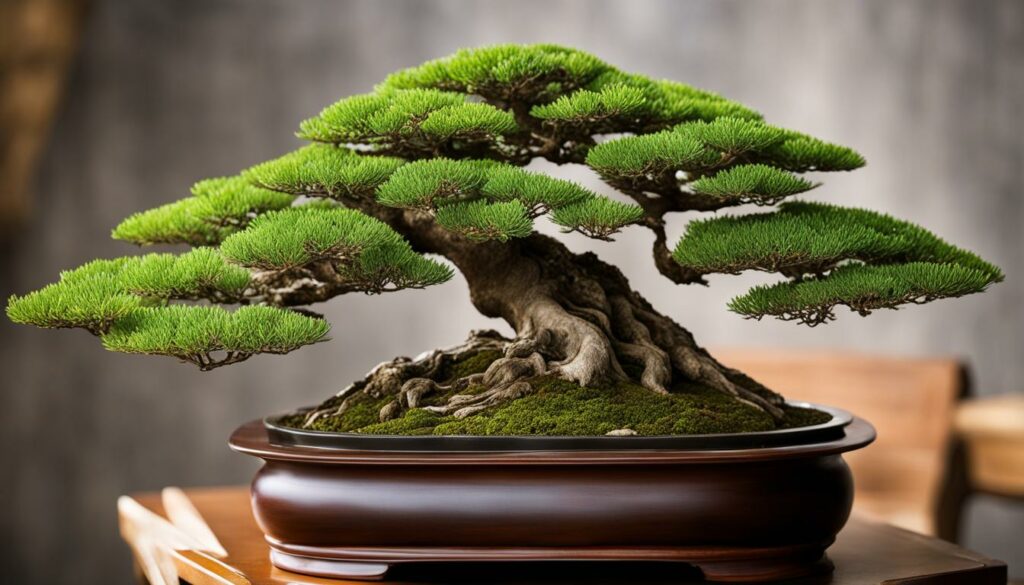
“Refining jin and shari techniques is an advanced aspect of bonsai styling where you create lifelike and visually captivating deadwood features. “
Advanced shaping techniques in refining jin and shari techniques take commitment, time, and practice, but they lead to significant improvements in your bonsai artistry.
Applying Advanced Defoliation Techniques
Once you have successfully shaped your bonsai’s branches and trunk, it’s time to refine its foliage density using advanced defoliation techniques. By removing select leaves, you can create a more balanced and aesthetically pleasing overall look for your bonsai.
Step-by-Step Defoliation Process
Follow these steps to apply advanced defoliation techniques:
- Carefully evaluate the current foliage density of your bonsai and plan which leaves to remove.
- Using sharp bonsai scissors, carefully remove the selected leaves. Be sure not to damage any surrounding foliage or the rest of the bonsai.
- After removing the desired leaves, monitor your bonsai closely to ensure it is responding well to the defoliation process.
- If necessary, adjust the remaining leaves as needed to achieve the desired foliage density.
Remember, defoliation is not suitable for all bonsai species, and it should only be performed when your bonsai is healthy and strong enough to recover from the process.
Benefits of Advanced Defoliation Techniques
Applying advanced defoliation techniques can have several benefits for your bonsai, including:
- Reducing leaf size, creating a more natural and balanced look
- Preventing overcrowding and increasing light penetration to lower branches
- Encouraging new growth and improving ramification (branch division)
“By removing certain leaves from your bonsai, you can create a more refined and balanced look, while also promoting healthy growth and branch division.”
Mastering advanced defoliation techniques is a crucial aspect of bonsai styling and is essential for achieving bonsai mastery. With patience and practice, you can refine your defoliation skills and take your bonsai artistry to new heights.
Embracing Advanced Styling Tools and Techniques
You’ve learned about the various techniques for advanced bonsai shaping; now let’s explore the advanced styling tools available to further enhance your artistry. These tools are specifically designed for bonsai enthusiasts seeking to refine their skills and create truly remarkable miniature masterpieces.
Some essential advanced styling tools for complex styling include high-quality scissors, pliers, wire cutters, and carbon steel knives. These tools are instrumental in creating intricate details as well as a smooth finish on deadwood and shari.
For bonsai mastery, you’ll need a trunk splitter to divide the trunk evenly, a concave cutter to remove unwanted branches, and a jin plier for creating convincing deadwood features. These tools are advanced but essential for creating realistic designs.
Artistic techniques like grafting and defoliation require specialized tools. A grafting knife or saw is necessary, along with grafting tape or clips to hold the graft in place. Advanced defoliation techniques may require specialized brushes for applying the defoliating agent.
Remember, each tool requires proper handling and use to achieve the desired results. Mastery of these advanced styling tools takes time and practice. Choose the right tool for the job and apply it with care, and your bonsai artistry will advance to new heights.
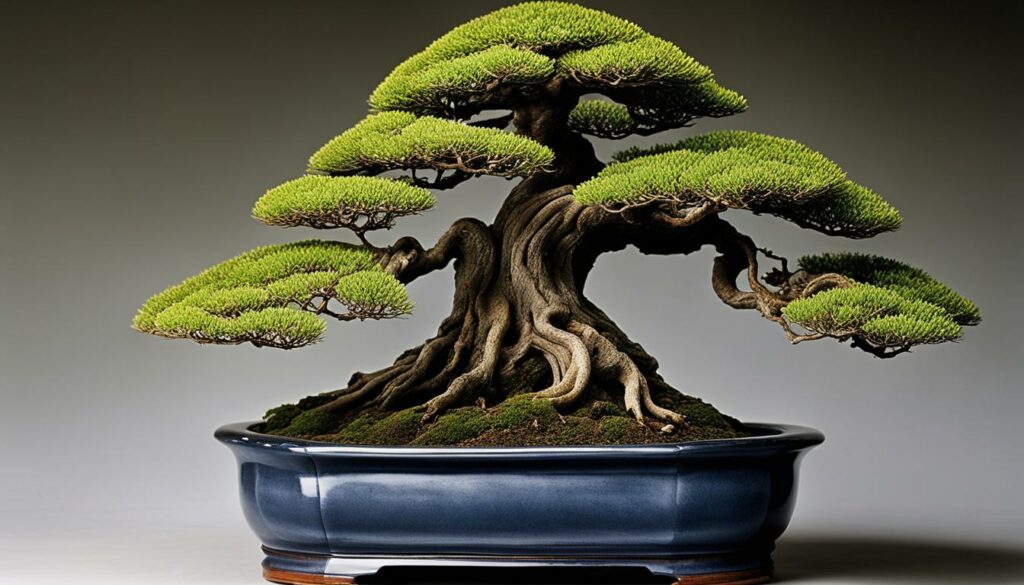
Advanced Styling Tools and Techniques
| Tool | Function |
|---|---|
| High-quality scissors | Create intricacies, remove unwanted foliage |
| Pliers | Shape the trunk and branches |
| Wire cutters | Trim and shape bonsai wire |
| Carbon steel knives | Carve deadwood and shari into intricate designs |
| Trunk splitter | Divide the trunk evenly |
| Concave cutter | Remove unwanted branches |
| Jin plier | Create convincing deadwood features |
Maintaining and Displaying Your Advanced Bonsai
Now that you have mastered complex styling and advanced bonsai shaping techniques, it’s equally important to maintain and display your miniature masterpieces with care and attention to detail. Here are some valuable tips and tricks for showcasing your bonsai artistry:
Maintaining Your Advanced Bonsai
Proper care is essential to keep your advanced bonsai looking healthy and vibrant. Follow these essential maintenance techniques:
- Water your bonsai regularly, making sure not to overwater or underwater.
- Fertilize your bonsai according to its specific needs, using high-quality bonsai fertilizer.
- Prune your bonsai periodically to maintain its shape and prevent overcrowding.
- Check for pests and diseases regularly and take prompt action to address any issues.
- Repot your bonsai every few years to ensure optimal health and growth.
By following these simple maintenance techniques, you can ensure that your advanced bonsai continues to thrive and flourish for years to come.
Displaying Your Advanced Bonsai
Once you have perfected the art of advanced bonsai shaping, it’s time to showcase your masterpiece in the most captivating way possible. Here are some suggestions for displaying your advanced bonsai:
- Choose a suitable display stand that complements the size and style of your bonsai.
- Place your bonsai in a well-lit area that receives indirect sunlight to ensure optimal growth and health.
- Rotate your bonsai periodically to ensure even growth and prevent uneven shaping.
- Consider incorporating accessories such as moss, rocks, or figurines to accentuate the aesthetic appeal of your bonsai design.
With these displaying techniques, you can create a captivating and visually engaging display that highlights the artistry and complexity of your advanced bonsai shaping techniques.
Remember, your advanced bonsai represents the culmination of your bonsai mastery and artistic techniques. By maintaining and displaying it with care and attention to detail, you can showcase your artistry and inspire other bonsai enthusiasts with your talent and dedication.
Conclusion
You’ve now explored a wide range of advanced bonsai shaping techniques designed for expert enthusiasts seeking to refine their skills and create exceptional miniature masterpieces. With dedication and practice, you can achieve bonsai mastery and develop a unique artistic style that captivates and delights.
Remember to take your time and approach each technique with precision and care. Advanced styling requires patience, attention to detail, and a willingness to experiment and refine your methods over time.
As you explore these advanced techniques, keep in mind the importance of maintaining and showcasing your bonsai creations. With proper care and attention, your miniature masterpieces can be displayed to their fullest potential and admired for years to come.
Thank you for joining us on this journey of advanced bonsai shaping. We hope this comprehensive guide has inspired you to continue your bonsai artistry and pursue new heights of creativity and mastery.
FAQ
What are advanced bonsai shaping techniques?
Advanced bonsai shaping techniques are specialized methods and practices used by expert bonsai enthusiasts to refine and perfect their miniature masterpieces. These techniques go beyond the basics of bonsai shaping and require a deeper understanding of complex styling and artistic techniques.
How can I understand complex styling in bonsai?
Understanding complex styling in bonsai involves studying and exploring the various artistic techniques used to create stunning bonsai designs. This includes learning about techniques such as branch structure, trunk movement, nebari and root systems, canopy silhouettes, wiring, grafting, refining jin and shari, and advanced defoliation techniques.
How can I master branch structure in bonsai?
Mastering branch structure in bonsai requires advanced shaping techniques. This involves understanding the intricate layout and balance of branches, as well as implementing methods to create visually appealing movement and taper. With practice and attention to detail, you can achieve a well-defined and harmonious branch structure in your bonsai.
How can I enhance trunk movement and taper in my bonsai?
Enhancing trunk movement and taper in bonsai involves applying advanced techniques to create captivating and natural-looking curves and angles in the trunk. This can be achieved through methods such as wiring, selective pruning, and carving. By carefully shaping the trunk, you can create a sense of elegance and visual interest in your bonsai.
Why is nebari and root system important in bonsai?
Nebari, which refers to the surface roots of a bonsai, and a well-developed root system play a vital role in creating a harmonious and aesthetically pleasing bonsai design. They provide stability, enhance the overall balance of the tree, and contribute to the lifelike appearance of the miniature masterpiece. Advanced shaping techniques can be used to perfect the nebari and root system of your bonsai.
How can I create lifelike canopy silhouettes in bonsai?
Creating lifelike canopy silhouettes in bonsai involves advanced techniques for shaping and arranging the foliage to mimic the natural patterns and density of full-sized trees. This can be achieved through techniques such as selective pruning, wiring, and defoliation. By carefully crafting the canopy, you can create an illusion of a mature and majestic tree in miniature form.
What are advanced wiring techniques in bonsai?
Advanced wiring techniques in bonsai are methods used to shape and manipulate the branches of the tree with precision. This involves understanding the appropriate timing, placement, and tension of wires to achieve desired branch positions. By employing advanced wiring techniques, you can create intricate and aesthetically pleasing designs in your bonsai.
How can I incorporate grafting techniques in bonsai?
Incorporating grafting techniques in bonsai allows you to unleash your creativity and create unique and striking designs. Grafting involves attaching a cutting or scion from one tree onto the trunk or branch of another tree. This technique can be used to introduce new branches, change the direction of growth, or create fusion between different species. With advanced styling techniques, grafting can be seamlessly integrated into your bonsai designs.
How can I refine jin and shari techniques in bonsai?
Refining jin (deadwood) and shari (exposed trunk) techniques in bonsai involves advanced methods for creating realistic and visually captivating features. These techniques require careful carving, shaping, and aging of the deadwood areas to give the tree a sense of character, age, and natural beauty. With practice and attention to detail, you can refine your jin and shari techniques to elevate the aesthetic appeal of your bonsai.
What are advanced defoliation techniques in bonsai?
Advanced defoliation techniques in bonsai involve selectively removing or thinning out foliage to create a more refined and balanced look. This technique allows you to control the density and distribution of leaves, enhancing the overall aesthetic of the tree. Advanced defoliation techniques require knowledge of the specific needs of different species and careful timing to achieve optimal results.
What tools and techniques can I use for advanced bonsai styling?
There is a wide range of tools and techniques available to bonsai enthusiasts for advanced styling. Some essential tools include concave cutters, knob cutters, root hooks, wire cutters, and various gauges of bonsai wire. Techniques such as carving, bending, and grafting can also be employed. Understanding how to effectively use these tools and techniques is key to creating intricate and visually stunning designs.
How can I maintain and display my advanced bonsai?
Maintaining and displaying your advanced bonsai requires a combination of proper care techniques and thoughtful presentation. This includes providing the right watering, pruning, and fertilization regimen, as well as protecting your bonsai from harsh elements. Additionally, choosing an appropriate display container, stand, or accent pieces can enhance the overall aesthetic impact of your advanced bonsai.
